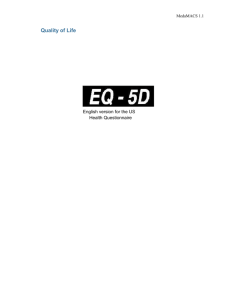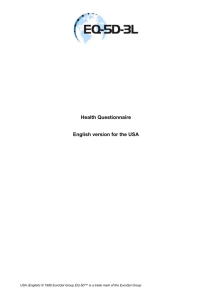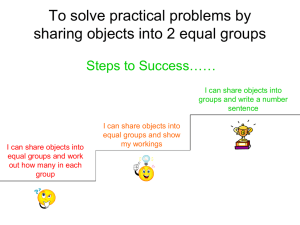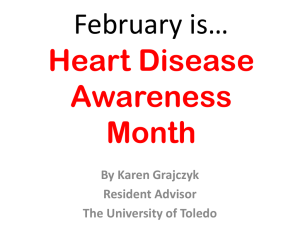Subjective life expectancy influences TTO
advertisement
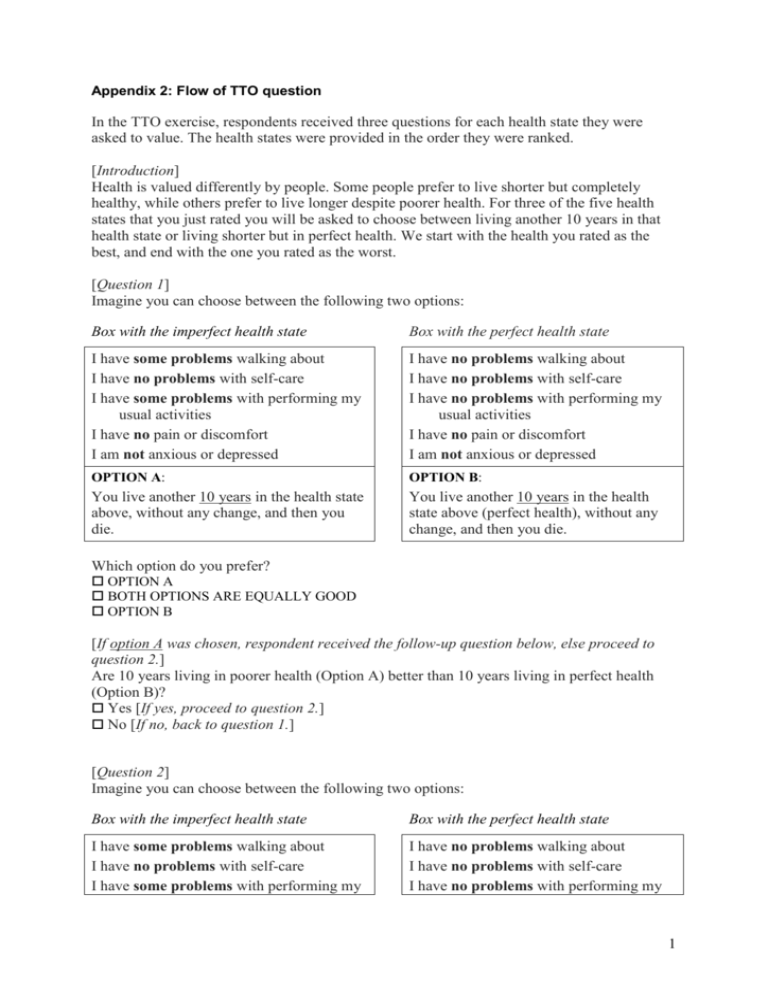
Appendix 2: Flow of TTO question In the TTO exercise, respondents received three questions for each health state they were asked to value. The health states were provided in the order they were ranked. [Introduction] Health is valued differently by people. Some people prefer to live shorter but completely healthy, while others prefer to live longer despite poorer health. For three of the five health states that you just rated you will be asked to choose between living another 10 years in that health state or living shorter but in perfect health. We start with the health you rated as the best, and end with the one you rated as the worst. [Question 1] Imagine you can choose between the following two options: Box with the imperfect health state Box with the perfect health state I have some problems walking about I have no problems with self-care I have some problems with performing my usual activities I have no pain or discomfort I am not anxious or depressed I have no problems walking about I have no problems with self-care I have no problems with performing my usual activities I have no pain or discomfort I am not anxious or depressed OPTION A: OPTION B: You live another 10 years in the health state above, without any change, and then you die. You live another 10 years in the health state above (perfect health), without any change, and then you die. Which option do you prefer? OPTION A BOTH OPTIONS ARE EQUALLY GOOD OPTION B [If option A was chosen, respondent received the follow-up question below, else proceed to question 2.] Are 10 years living in poorer health (Option A) better than 10 years living in perfect health (Option B)? Yes [If yes, proceed to question 2.] No [If no, back to question 1.] [Question 2] Imagine you can choose between the following two options: Box with the imperfect health state Box with the perfect health state I have some problems walking about I have no problems with self-care I have some problems with performing my I have no problems walking about I have no problems with self-care I have no problems with performing my 1 usual activities I have no pain or discomfort I am not anxious or depressed usual activities I have no pain or discomfort I am not anxious or depressed OPTION A: OPTION B: You live another 10 years in the health state above, without any change, and then you die. You live another 5 years in the health state above (perfect health), without any change, and then you die. Which option do you prefer? OPTION A BOTH OPTIONS ARE EQUALLY GOOD OPTION B [If both options are equally good was chosen, respondent received the follow-up question below, else proceed to question 3.] Do you find living 5 years in perfect health (Option B) equally good as living 10 years in poorer health (Option A)? Yes [If yes, proceed to question 3.] No [If no, back to question 2.] [Question 3] Suppose you can choose between living 10 years in poorer health or less than ten years in perfect health. In both cases you die afterwards. Box with the imperfect health state Box with the perfect health state I have some problems walking about I have no problems with self-care I have some problems with performing my usual activities I have no pain or discomfort I am not anxious or depressed I have no problems walking about I have no problems with self-care I have no problems with performing my usual activities I have no pain or discomfort I am not anxious or depressed OPTION A: OPTION B: You live another 10 years in the health state above, without any change, and then you die. You live less than X years in the health state above (perfect health), without any change, and then you die. Note: X=10 if respondent chose option A in question 2; X=5 if respondent chose option B in question 2. Please indicate on the scale below the minimum number of years that you would like to live in option B in order to make it equally good to option A. How many years in perfect health (option B) would make both options equally good? [Respondents were presented with a visual analogue scale ranging from 0 to X, with X=10 if respondent had chosen option A in question 2 and X=5 if respondent had chosen option B. The label of the scale was ‘years’. Below the scale the following text was printed: “I find both 2 options equally good when I’d live another … years in option B” (with the scale value displayed on the dots, at 1 decimal level)]. [After the respondent indicated a value, the following question was asked.] Do you really find living 10 years in poorer health (Option A) equally good as living Y years in perfect health (Option B)? Yes [If yes, proceed to next question .] No [If no, back to question 3.] 3
